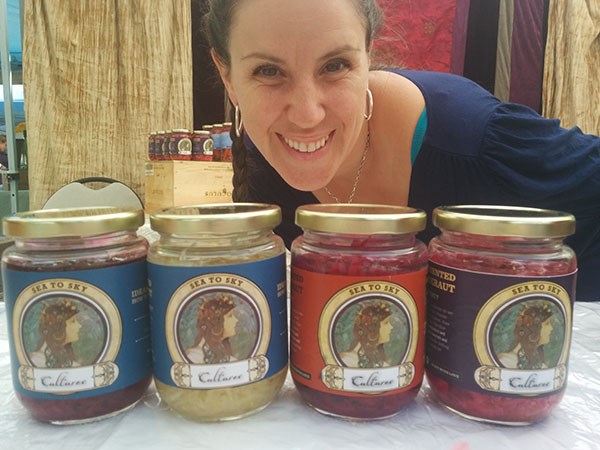Making sauerkraut wasn’t a family tradition, but when her twin girls became sick at just 13 months old, Amber Butler, owner and operator of Sea to Sky Cultures, knew something had to change.
“It was basically five months of non-stop illness,” says Butler. “People were telling me it was normal to get sick… but I want my family to be as healthy as possible.”
While researching foods that support the immune system, she discovered sauerkraut.
“I started making it and feeding it to our whole family,” Butler says.
Twelve months later no one has
been sick.
“I feel it was a huge influence as to why we rounded the corner and started feeling better,” she said.
She now sells her homemade sauerkraut at the Squamish Farmers’ Market and is encouraging all families (especially children) to try it. She also hopes to be selling her jars commercially soon.
Many people know sauerkraut as the limp, vinegar-laced, hot dog topping on supermarket shelves. But Butler’s fresh, fermented sauerkraut couldn’t be more different. Her tangy, crunchy cabbage is usually organic and often local. It’s chopped, washed, salted and packed by hand, and left to ferment for approximately six weeks. During this time, a diverse population of good bacteria is produced, turning it essentially into a cost-effective jar of delicious, affordable probiotics.
“It’s a raw living food,” says Butler.
There’s more to Butler’s sauerkraut though than just red and green cabbage. She offers spicy, fruity and even tropical flavours, including fennel and dill seed, juniper berry, mango, pineapple
and coconut.
“I also have beet and carrot… horseradish, chive and paprika… apple, ginger and garlic. Then I have dill pickles and garlic dill carrots,” she said.
Though fermentation has recently become more popular, it’s a traditional process with a long history, and was originally used to preserve food, providing a source of nutrients throughout winter.
Aside from offering good nutrition, sauerkraut is also believed to have many health benefits including aiding digestion, promoting the growth of healthy bacteria in the gut, balancing stomach pH, and even treating stomach ulcers.
“It’s got tons of vitamin C, magnesium and calcium. It’s just really incredible,” Butler adds.
If you’re new to sauerkraut, a whole jar can be a little intimidating, but Butler is full of ideas as to how you can eat it.
“Maybe you puree it and put it into your salad dressing, or maybe you just use the brine and put it into a sauce,” she says. “Even if you’re not in love with it, you should find a way to consume it. We just snack on it. In replacement of chips we have sauerkraut. It could be part of the meal, before the meal or a snack in between.”
If you’d like to learn more about fermentation, Butler is running a course at Brennan Park in September. She’s also happy to share her process with others. If you’d like to watch her at work, please contact her through the Sea to Sky Cultures’ Facebook page, visit her at Squamish Farmers’ Market or email [email protected].




